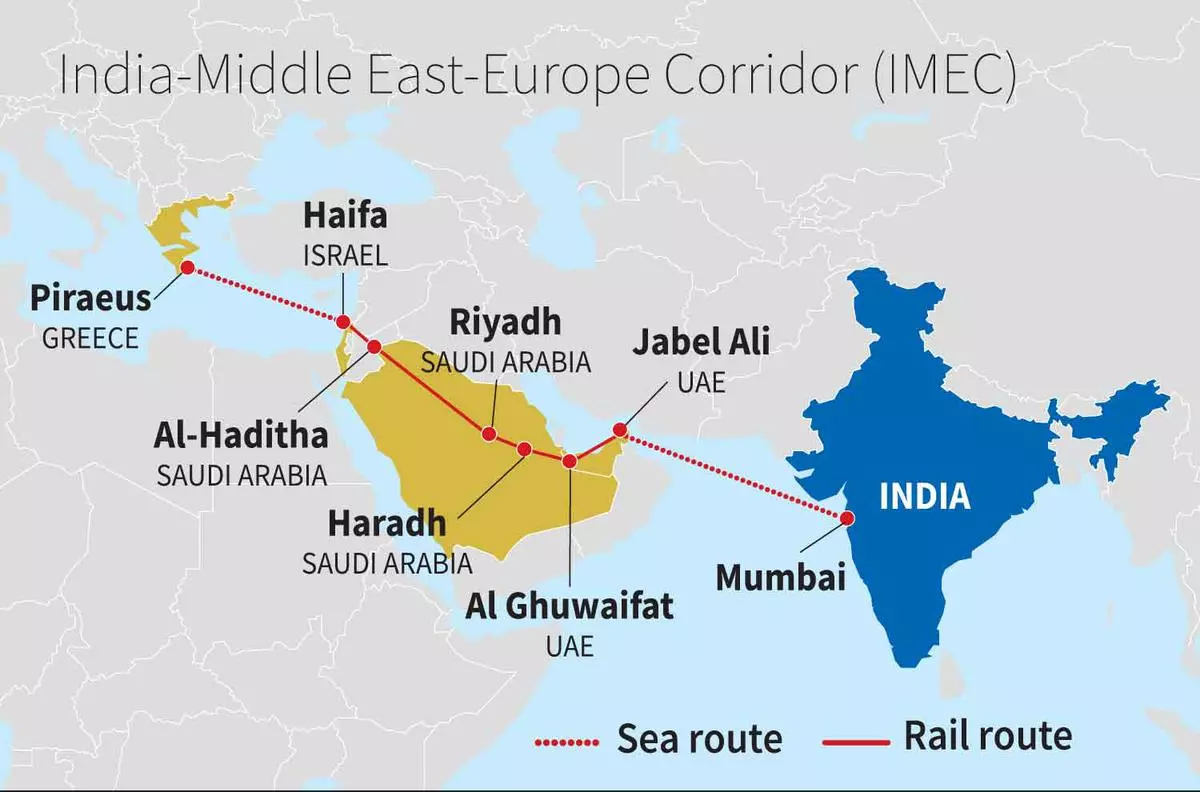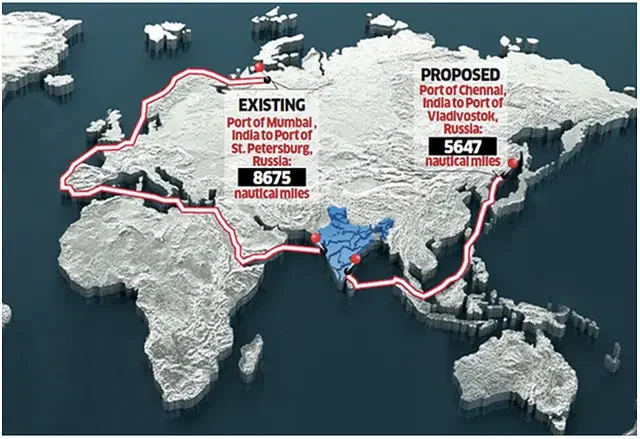Indian Economy
Developments in India’s Maritime Sector
- 20 Nov 2024
- 11 min read
For Prelims: Blue Economy, Critical Minerals, India-Middle East-Europe Economic Corridor, G20 New Delhi Summit 2023, Vizhinjam International Seaport, Vadhavan, Galathea Bay, Port Authority Act, 2021, National Waterways Act, 2016, Inland Vessel Act, 2021, Recycling of Ships Act, 2019, Lothal, Chennai-Vladivostok Maritime Corridor, Northern Sea Route, International North-South Transport Corridor, Belt and Road Initiative (BRI), Sagarmala Program, Make in India, Indian Ocean Rim Association (IORA).
For Mains: Significance of maritime trade in economic developments, Key developments in recent past.
Why in News?
The Ministry of Ports, Shipping and Waterways, in collaboration with the Observer Research Foundation (ORF), organized the inaugural Sagarmanthan: The Great Oceans Dialogue, highlighting key developments in India’s maritime sector, focusing on maritime logistics, ports, and shipping.
What are the Key Developments in India’s Maritime Sector?
- Chennai-Vladivostok Eastern Maritime Corridor: It became operational at the end of 2023, facilitating cargo transport between India and Far East Russia handling key imports like crude, food, and machinery.
- India-Middle East-Europe Economic Corridor (IMEC): It announced at the G20 New Delhi Summit 2023, spans over 4,800 km, connecting India to the UAE, Saudi Arabia, Jordan, Israel, and European nations—Italy, France, and Greece—via a railway and sea route. India and Greece are collaborating on this initiative.
- Maritime Vision 2047: India aims to be the top maritime nation by 2047, focusing on ports, cargo, ship ownership, shipbuilding, and reforms.
- India is also working on building a port handling capacity of 10,000 million metric tonnes per annum by 2047.
- Investment in Maritime Infrastructure: India plans to invest Rs 80 lakh crore in the maritime sector in key projects like Vizhinjam international seaport in Kerala, new mega ports at Vadhavan (Maharashtra) and Galathea Bay (Nicobar Islands).
- Advancement towards building ships powered by clean fuels like ammonia, hydrogen, and electricity for sustainability.
- Port Turnaround Time: Port turnaround times have improved significantly, reducing from over 40 to 22 hours, surpassing nations like the US and Singapore.
- Port turnaround time represents the time a ship takes to unload, load, perform operations, and be ready for the next voyage.
- Revamped Legislation: Major Port Authority Act, 2021, National Waterways Act, 2016, Inland Vessel Act, 2021, and Recycling of Ships Act, 2019 had already accelerated growth in the ports, waterways, and ship recycling sectors.
- The Coastal Shipping Bill, 2024, and the Merchant Shipping Bill, 2020, will soon boost coastal shipping, shipbuilding, and recycling in India.
- Preserving Legacy: The national maritime heritage complex is being built at Lothal to revive India's shipbuilding legacy.
IMEC
- It is a major infrastructure and trade connectivity project aimed at enhancing economic and trade links between India, the Middle East, and Europe.
- The proposed IMEC will consist of Railroad, Ship-to-Rail networks and Road transport routes extending across two corridors:
- The East Corridor – connecting India to the Arabian Gulf,
- The Northern Corridor – connecting the Arabian Gulf to Europe.
- The IMEC corridor will also include an electricity cable, a hydrogen pipeline and a high-speed data cable.
Chennai-Vladivostok Maritime Corridor?
- About: The Chennai-Vladivostok Maritime Corridor is a sea link connecting the east coast of India with ports in the far-east region of Russia, particularly the Chennai Port and Vladivostok Port.
- Distance Reduction: The new route cuts the distance from 8,675 nautical miles (via Europe) to approximately 5,600 nautical miles.
- Time Reduction: It significantly reduces the time required to transport goods between India and Far East Russia by up to 16 days, with the journey now taking 24 days compared to the previous 40 days.
- Strategic Importance: Vladivostok is the largest Russian port on the Pacific Ocean, and it is located about 50 kilometres from the China-Russia border.
- Trade Potential: A feasibility study indicates significant potential for trading commodities such as coking coal, oil, fertilisers, containers, and liquefied natural gas (LNG) between India and Russia.
- Complementary Initiatives: The Chennai-Vladivostok corridor is aligned with other initiatives, such as the Northern Sea Route and the International North-South Transport Corridor (INSTC).
What are the Challenges in India’s Maritime Sector?
- Competition from China: In less than 70 years, China has become a global maritime power, with a large navy, coast guard, the largest merchant fleet, and leading ports.
- Its Belt and Road Initiative (BRI) further strengthens its position as a maritime competitor.
- Inefficient Port Infrastructure: The modernization of existing ports and the construction of new ports have faced delays, and many objectives under the Maritime Agenda 2010-2020 were not met by 2020.
- While port connectivity is a focus of the Sagarmala program, intermodal transportation (especially linking ports to inland transport networks) remains underdeveloped.
- Lack of Private Sector Participation: India’s maritime economy, particularly in the context of port-led industrialization, still suffers from insufficient involvement of private players.
- Sustainability Concerns: Maritime trade and port development often face environmental scrutiny, especially with regard to coastal ecosystem degradation and the environmental impact of large infrastructure projects.
- Geopolitical Challenges: The shifting geopolitical dynamics and new global maritime challenges, such as threat of non-state actors (e.g., Houthis attack on commercial vessels) pose risks to India’s maritime trade.
- Dependence on Foreign Shipbuilding: Despite strides in indigenous shipbuilding, India remains largely dependent on foreign technology for shipbuilding and maritime equipment.
What are Recent Government Initiatives in India’s Maritime Sector?
Way Forward
- Fast-Tracking Port Modernization: The Sagarmala Programme, launched to promote port-led industrialization, should be expedited, with a focus on prioritising the modernisation of domestic shipyards, reducing bureaucratic hurdles and ensuring timely project implementation.
- Incentivizing Private Investment: The government should provide more incentives for private participation in the maritime sector through favourable policies, tax breaks, and investment-friendly regulations.
- Promotion of Port-Led Industrialization: India should focus on creating industrial clusters around ports, making use of the Make in India initiative.
- Promotion of Green Shipping: The promotion of alternative fuels like LNG (liquefied natural gas) and renewable energy sources for vessels can reduce the carbon footprint of maritime trade.
- Multilateral Maritime Cooperation: India should increase its engagement with regional and multilateral security frameworks, such as the Indian Ocean Rim Association (IORA) to ensure cooperative maritime security.
|
Drishti Mains Question: Q. Examine the recent advancements in India’s maritime sector and analyze how they contribute to strengthening the country's economic growth and strategic partnerships globally. |
UPSC Civil Services Examination, Previous Year’s Question (PYQs)
Prelims
Q.Consider the following in respect of Indian Ocean Naval Symposium (IONS): (2017)
1. Inaugural IONS was held in India in 2015 under the chairmanship of the Indian Navy.
2. IONS is a voluntary initiative that seeks to increase maritime co-operation among navies of the littoral states of the Indian Ocean Region.
Which of the above statements is/are correct?
(a) 1 only
(b) 2 only
(c) Both 1 and 2
(d) Neither 1 nor 2
Ans: (b)
Q.With reference to ‘Indian Ocean Rim Association for Regional Cooperation (IOR-ARC)’, consider the following statements: (2015)
1. It was established very recently in response to incidents of piracy and accidents of oil spills.
2. It is an alliance meant for maritime security only.
Which of the statements given above is/ are correct?
(a) 1 only
(b) 2 only
(c) Both 1 and 2
(d) Neither 1 nor 2
Ans: (d)
Q.Southeast Asia has captivated the attention of the global community over space and time as a geostrategically significant region. Which among the following is the most convincing explanation for this global perspective? (2011)
(a) It was the hot theatre during the Second World War
(b) Its location between the Asian powers of China and India
(c) It was the arena of superpower confrontation during the Cold War period
(d) Its location between the Pacific and Indian oceans and its preeminent maritime character
Ans: (d)
Mains
Q.Project ‘Mausam’ is considered a unique foreign policy initiative of the Indian government to improve relationships with its neighbours. Does the project have a strategic dimension? Discuss.(2015)
Q.With respect to the South China sea, maritime territorial disputes and rising tension affirm the need for safeguarding maritime security to ensure freedom of navigation and overflight throughout the region. In this context, discuss the bilateral issues between India and China. (2014)






